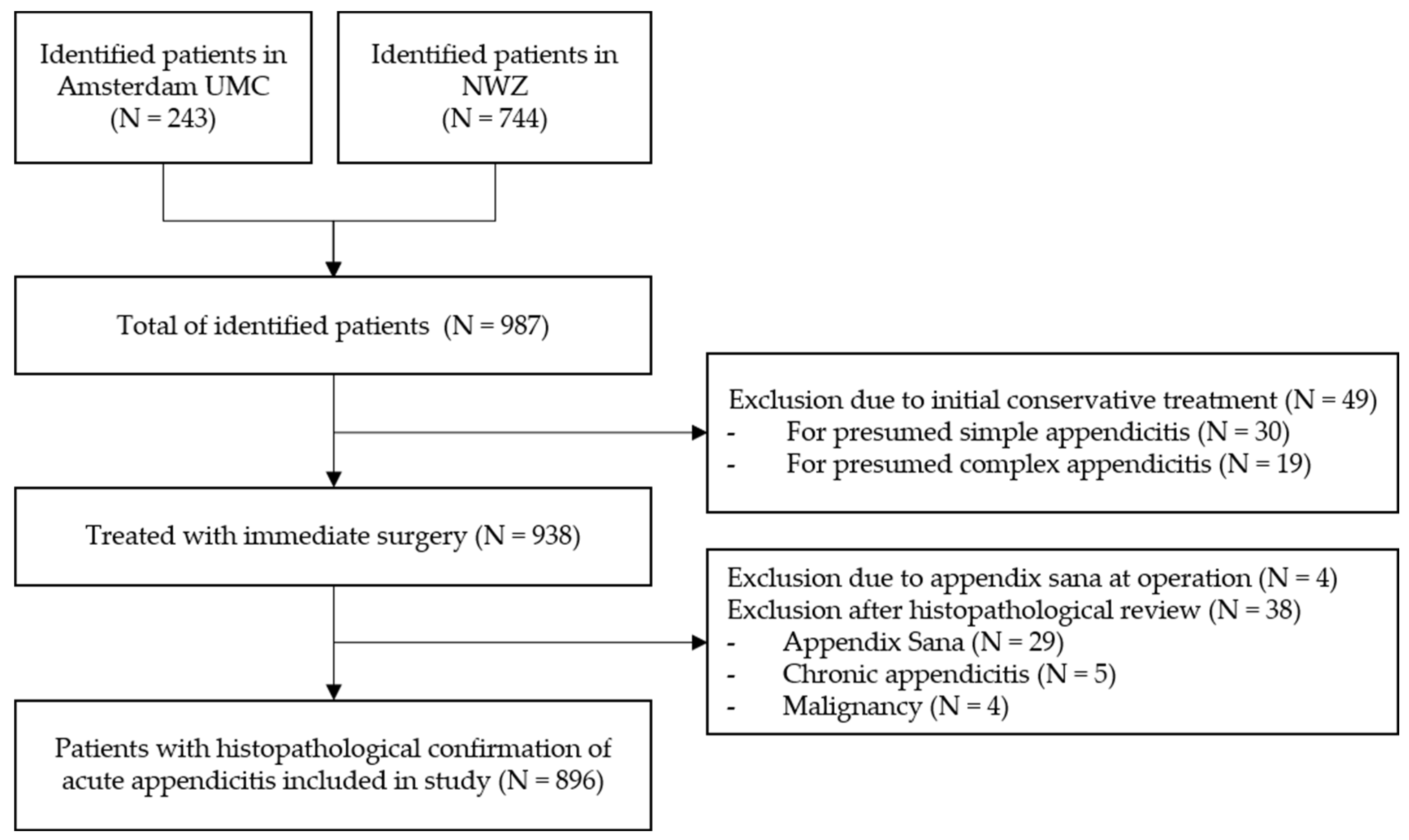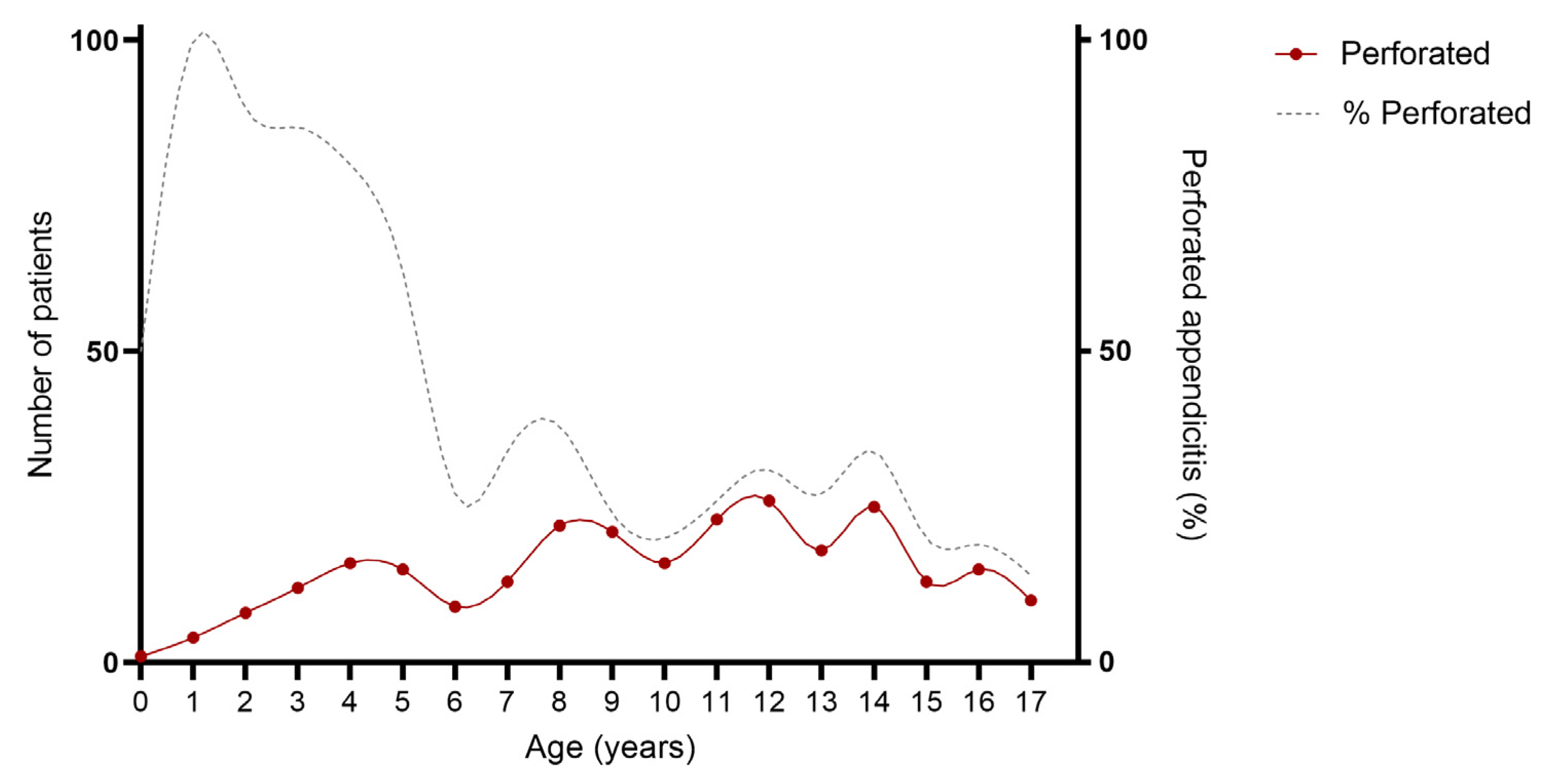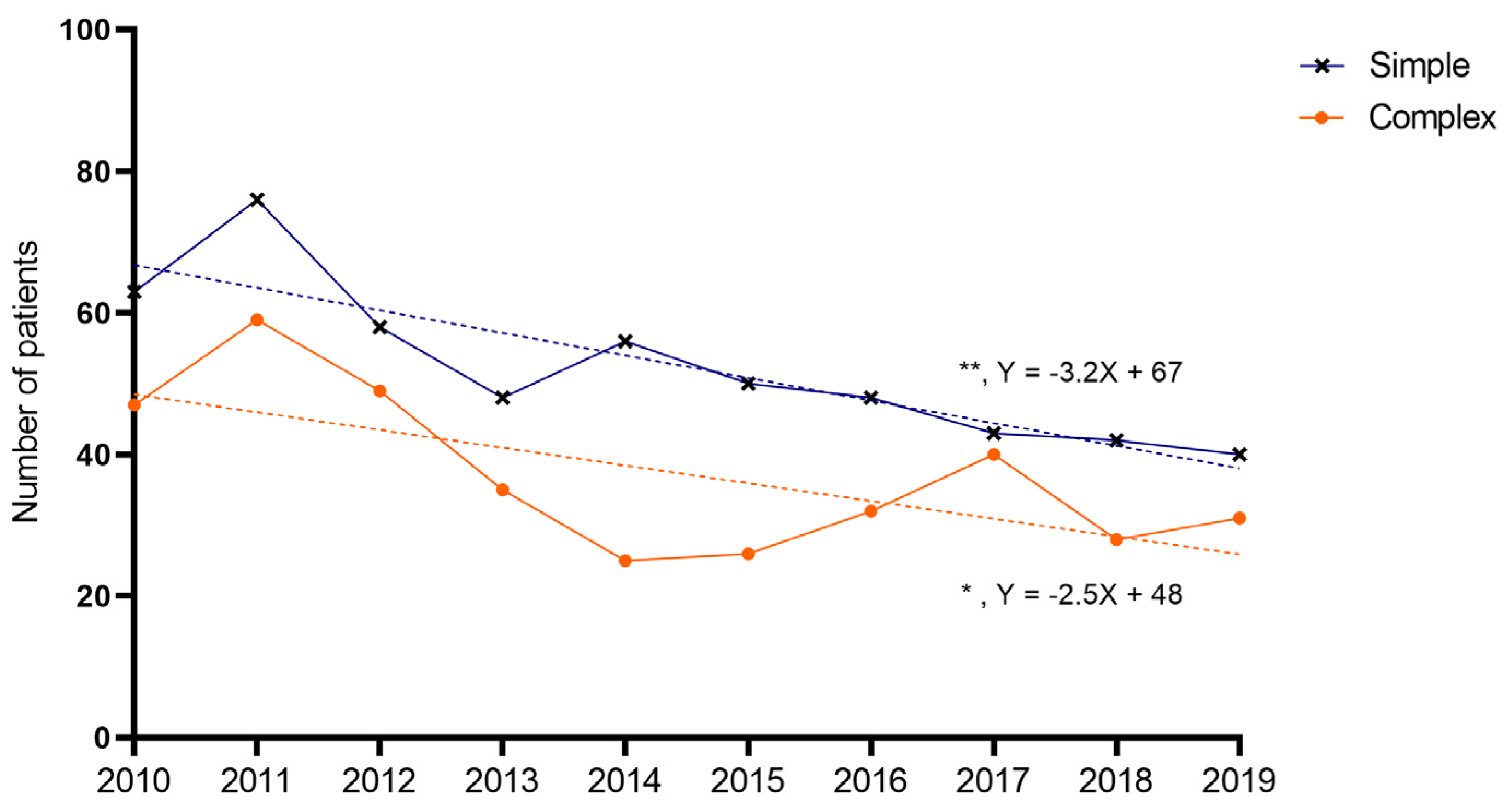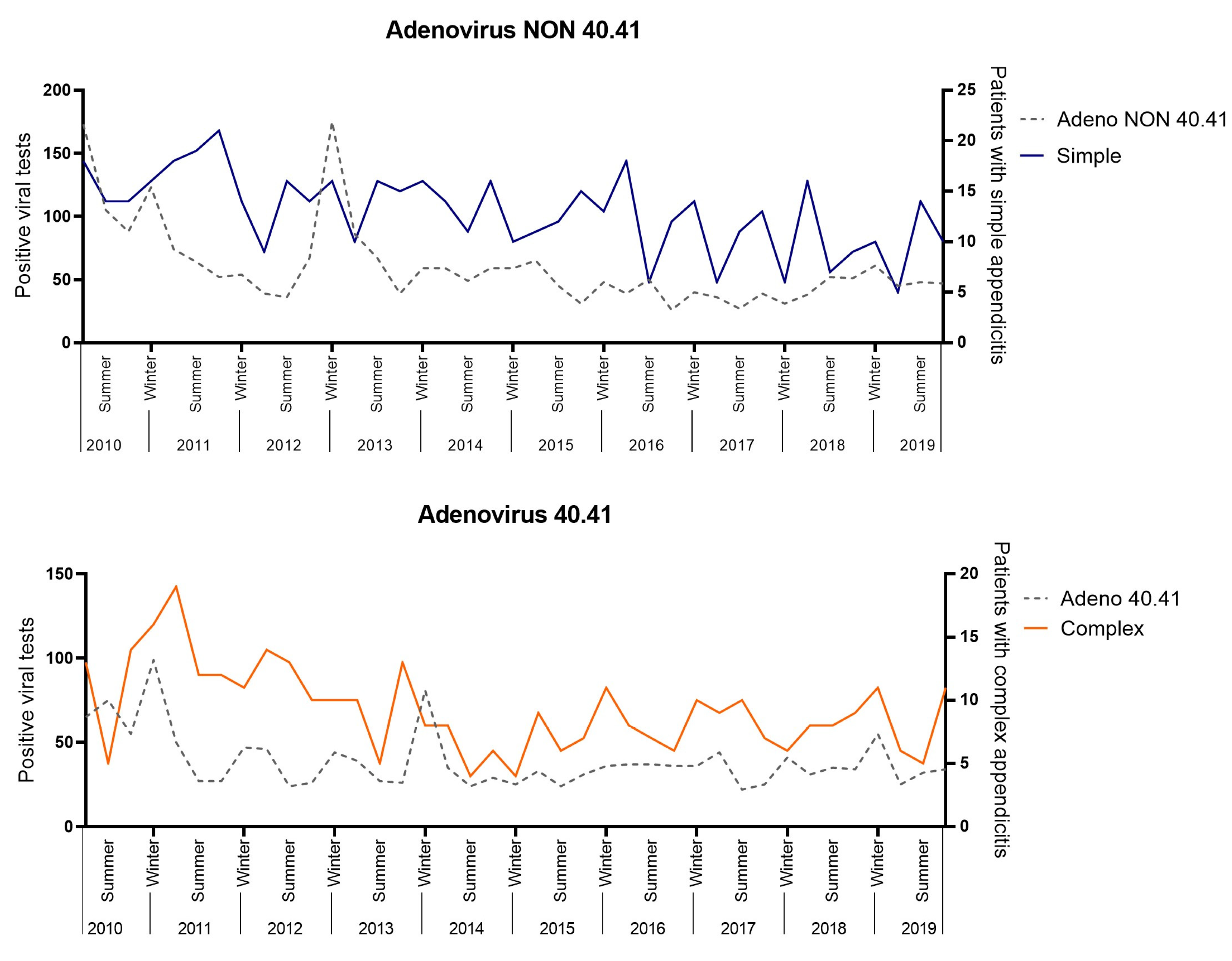Trends in Simple and Complex Appendicitis in Children and the Potential Correlation to Common Viral Pathogens—A Retrospective Cohort Study between 2010 and 2019 in The Netherlands
Abstract
:1. Introduction
2. Materials and Methods
2.1. Clinical Data Collection
2.2. Clinical and Pathological Classification
2.3. Viral Data Collection
2.4. Outcomes
2.5. Statistics
3. Results
3.1. The Clinical Presentation of Simple and Complex Appendicitis According to Age
3.2. The Annual Distribution of Simple and Complex Appendicitis in Children over the Last Decade (2010–2019)
3.3. The Seasonal and Monthly Distribution of Simple and Complex Appendicitis in Children
3.4. Do Viral Infections Coincide with Simple and Complex Appendicitis in Children?
4. Discussion
4.1. The Association between the Age of Children and Complex Appendicitis
4.2. What Causes the Decline in Children with Simple and Complex Appendicitis?
4.3. Data from This Cohort Study Show No Relevant Seasonal Variation in Simple or Complex Appendicitis in Children
4.4. Is There a Role for Viruses in Simple and Complex Appendicitis in Children?
4.5. Limitations
4.6. Future Studies
5. Conclusions
Supplementary Materials
Author Contributions
Funding
Institutional Review Board Statement
Informed Consent Statement
Data Availability Statement
Acknowledgments
Conflicts of Interest
References
- Carr, N.J. The Pathology of Acute Appendicitis. Ann. Diagn. Pathol. 2000, 4, 46–58. [Google Scholar] [CrossRef]
- Bhangu, A.; Søreide, K.; Di Saverio, S.; Assarsson, J.H.; Drake, F.T. Acute Appendicitis: Modern Understanding of Pathogenesis, Diagnosis, and Management. Lancet 2015, 386, 1278–1287. [Google Scholar] [CrossRef]
- The, S.M.L.; Bakx, R.; Budding, A.E.; de Meij, T.G.J.; van der Lee, J.H.; Bunders, M.J.; Poort, L.; Heij, H.A.; van Heurn, L.W.E.; Gorter, R.R. Microbiota of Children with Complex Appendicitis: Different Composition and Diversity of The Microbiota in Children with Complex Compared with Simple Appendicitis. Pediatr. Infect. Dis. J. 2019, 38, 1054–1060. [Google Scholar] [CrossRef] [PubMed]
- Rubér, M.; Andersson, M.; Petersson, B.F.; Olaison, G.; Andersson, R.E.; Ekerfelt, C. Systemic Th17-like Cytokine Pattern in Gangrenous Appendicitis but Not in Phlegmonous Appendicitis. Surgery 2010, 147, 366–372. [Google Scholar] [CrossRef] [PubMed]
- Peeters, T.; Martens, S.; D’Onofrio, V.; Stappers, M.H.T.; van der Hilst, J.C.H.; Houben, B.; Achten, R.; Joosten, L.A.B.; Gyssens, I.C. An Observational Study of Innate Immune Responses in Patients with Acute Appendicitis. Sci. Rep. 2020, 10, 17352. [Google Scholar] [CrossRef] [PubMed]
- Vanhatalo, S.; Munukka, E.; Kallonen, T.; Sippola, S.; Grönroos, J.; Haijanen, J.; Hakanen, A.J.; Salminen, P. Appendiceal Microbiome in Uncomplicated and Complicated Acute Appendicitis: A Prospective Cohort Study. PLoS ONE 2022, 17, e0276007. [Google Scholar] [CrossRef] [PubMed]
- Omling, E.; Salö, M.; Stenström, P.; Merlo, J.; Gudjonsdottir, J.; Rudolfson, N.; Hagander, L. Nationwide Paediatric Cohort Study of a Protective Association between Allergy and Complicated Appendicitis. Br. J. Surg. 2021, 108, 1491–1497. [Google Scholar] [CrossRef]
- Arredondo Montero, J.; Pérez Riveros, B.P.; Martín-Calvo, N. Diagnostic Performance of Total Platelet Count, Platelet-to-Lymphocyte Ratio, and Lymphocyte-to-Monocyte Ratio for Overall and Complicated Pediatric Acute Appendicitis: A Systematic Review and Meta-Analysis. Surg. Infect. 2023, 24, 311–321. [Google Scholar] [CrossRef] [PubMed]
- The, S.-M.M.L.; de Meij, T.G.J.; Budding, A.E.; Bakx, R.; van der Lee, J.H.; Poort, L.; Cense, H.A.; Heij, H.A.; van Heurn, L.W.E.; Gorter, R.R. The Potential of Rectal Swabs to Differentiate Simple and Complex Appendicitis in Children with a Microbiota-Based Test. Eur. J. Pediatr. 2022, 181, 4221–4226. [Google Scholar] [CrossRef]
- Bekiaridou, K.; Kambouri, K.; Giatromanolaki, A.; Foutzitzi, S.; Kouroupi, M.; Aggelidou, M.; Deftereos, S. Predicting Complicated Appendicitis in Children: Pros and Cons of a New Score Combining Clinical Signs, Laboratory Values, and Ultrasound Images (CLU Score). Diagnostics 2023, 13, 2275. [Google Scholar] [CrossRef]
- Feng, W.; Zhao, X.-F.; Li, M.-M.; Cui, H.-L. A Clinical Prediction Model for Complicated Appendicitis in Children Younger than Five Years of Age. BMC Pediatr. 2020, 20, 401. [Google Scholar] [CrossRef]
- Fares, A. Summer Appendicitis. Ann. Med. Health Sci. Res. 2014, 4, 18–21. [Google Scholar] [CrossRef] [PubMed]
- Kaplan, G.G.; Dixon, E.; Panaccione, R.; Fong, A.; Chen, L.; Szyszkowicz, M.; Wheeler, A.; MacLean, A.; Buie, W.D.; Leung, T.; et al. Effect of Ambient Air Pollution on the Incidence of Appendicitis. C. Can. Med. Assoc. J. J. L’assoc. Medicale Can. 2009, 181, 591–597. [Google Scholar] [CrossRef] [PubMed]
- Simmering, J.E.; Polgreen, L.A.; Talan, D.A.; Cavanaugh, J.E.; Polgreen, P.M. Association of Appendicitis Incidence with Warmer Weather Independent of Season. JAMA Netw. Open 2022, 5, e2234269. [Google Scholar] [CrossRef]
- Rautava, L.; Rautava, P.; Sipilä, J.; Kytö, V. Occurrence and Treatment of Pediatric Appendicitis in Finland 2004–2014. J. Surg. Res. 2018, 232, 33–38. [Google Scholar] [CrossRef] [PubMed]
- Zhang, Y.; Lyu, F.X.; Kang, Q.; Dong, Z.X.; Zhao, T.X.; Xie, S.N.; Luo, Q. Association of Meteorological Factors with Pediatric Acute Appendicitis in China: A 7-Year Retrospective Analysis. Medicine 2018, 97, e12913. [Google Scholar] [CrossRef] [PubMed]
- Deng, Y.; Chang, D.C.; Zhang, Y.; Webb, J.; Gabre-Kidan, A.; Abdullah, F. Seasonal and Day of the Week Variations of Perforated Appendicitis in US Children. Pediatr. Surg. Int. 2010, 26, 691–696. [Google Scholar] [CrossRef]
- Jangra, B.; Jangra, M.S.; Rattan, K.N.; Kadian, Y.S. Seasonal and Day of Week Variations in Acute Appendicitis in North Indian Children. J. Indian Assoc. Pediatr. Surg. 2013, 18, 42–43. [Google Scholar] [CrossRef]
- Hsu, Y.-J.; Fu, Y.-W.; Chin, T. Seasonal Variations in the Occurrence of Acute Appendicitis and Their Relationship with the Presence of Fecaliths in Children. BMC Pediatr. 2019, 19, 443. [Google Scholar] [CrossRef]
- Gallerani, M.; Boari, B.; Anania, G.; Cavallesco, G.; Manfredini, R. Seasonal Variation in Onset of Acute Appendicitis. Clin. Ter. 2006, 157, 123–127. [Google Scholar]
- Alder, A.C.; Fomby, T.B.; Woodward, W.A.; Haley, R.W.; Sarosi, G.; Livingston, E.H. Association of Viral Infection and Appendicitis. Arch. Surg. 2010, 145, 63–71. [Google Scholar] [CrossRef]
- Almström, M.; Svensson, J.F.; Svenningsson, A.; Hagel, E.; Wester, T. Population-Based Cohort Study on the Epidemiology of Acute Appendicitis in Children in Sweden in 1987–2013. BJS Open 2018, 2, 142–150. [Google Scholar] [CrossRef] [PubMed]
- Omling, E.; Salö, M.; Saluja, S.; Bergbrant, S.; Olsson, L.; Persson, A.; Björk, J.; Hagander, L. Nationwide Study of Appendicitis in Children. Br. J. Surg. 2019, 106, 1623–1631. [Google Scholar] [CrossRef]
- Pogorelić, Z.; Domjanović, J.; Jukić, M.; Poklepović Peričić, T. Acute Appendicitis in Children Younger than Five Years of Age: Diagnostic Challenge for Pediatric Surgeons. Surg. Infect. 2020, 21, 239–245. [Google Scholar] [CrossRef]
- Raveenthiran, V. Neonatal Appendicitis (Part 1): A Review of 52 Cases with Abdominal Manifestation. J. Neonatal. Surg. 2015, 4, 4. [Google Scholar] [CrossRef]
- Šimonovský, V. Normal Appendix: Is There Any Significant Difference in the Maximal Mural Thickness at US between Pediatric and Adult Populations? Radiology 2002, 224, 333–337. [Google Scholar] [CrossRef] [PubMed]
- Malas, M.A.; Sulak, O.; Gökçimen, A.; Sari, A. Development of the Vermiform Appendix during the Fetal Period. Surg. Radiol. Anat. 2004, 26, 202–207. [Google Scholar] [CrossRef] [PubMed]
- Sabrina, J.D.; Tan, C.W.; Nallusamy, M. Neonatal Perforated Appendicitis. J. Pediatr. Surg. Case Rep. 2018, 38, 66–68. [Google Scholar] [CrossRef]
- Almaramhy, H.H. Acute Appendicitis in Young Children Less than 5 Years: Review Article. Ital. J. Pediatr. 2017, 43, 15. [Google Scholar] [CrossRef] [PubMed]
- Ceresoli, M.; Coccolini, F.; Magnone, S.; Lucianetti, A.; Bisagni, P.; Armao, T.; Ansaloni, L.; Zago, M.; Chiarugi, M.; Catena, F.; et al. The Decrease of Non-Complicated Acute Appendicitis and the Negative Appendectomy Rate during Pandemic. Eur. J. Trauma Emerg. Surg. 2021, 47, 1359–1365. [Google Scholar] [CrossRef] [PubMed]
- van Amstel, P.; El Ghazzaoui, A.; Hall, N.J.; Wester, T.; Morini, F.; van der Lee, J.H.; Singer, G.; Pierro, A.; Zani, A.; Gorter, R.R. Paediatric Appendicitis: International Study of Management in the COVID-19 Pandemic. Br. J. Surg. 2022, 109, 1044–1048. [Google Scholar] [CrossRef] [PubMed]
- Pogorelić, Z.; Anand, S.; Žuvela, T.; Singh, A.; Križanac, Z.; Krishnan, N. Incidence of Complicated Appendicitis during the COVID-19 Pandemic versus the Pre-Pandemic Period: A Systematic Review and Meta-Analysis of 2782 Pediatric Appendectomies. Diagnostics 2022, 12, 127. [Google Scholar] [CrossRef] [PubMed]
- Lee, J.H.; Park, Y.S.; Choi, J.S. The Epidemiology of Appendicitis and Appendectomy in South Korea: National Registry Data. J. Epidemiol. 2010, 20, 97–105. [Google Scholar] [CrossRef] [PubMed]
- Lamps, L.W. Appendicitis and Infections of the Appendix. Semin. Diagn. Pathol. 2004, 21, 86–97. [Google Scholar] [CrossRef] [PubMed]
- Lynch, D.T.; Lott, L.; Cebe, K.; McDonald, J.M.; Abplanalp, A.; Tully, C.; Trujillo-Lopez, E.; Danaher, P.J. Adenovirus-Associated Acute Appendicitis: An Under-Recognized Relationship? Mil. Med. 2017, 182, e1765–e1768. [Google Scholar] [CrossRef]
- Soltani, S.; Kesheh, M.M.; Siri, G.; Faramarzi, S.; Shahbahrami, R.; Didehdar, M.; Erfani, Y.; Farahani, A. The Role of Viruses in Human Acute Appendicitis: A Systematic Literature Review. Int. J. Color. Dis. 2023, 38, 102. [Google Scholar] [CrossRef] [PubMed]
- Liu, M.; Lu, B.; Fan, H.; Guo, X.; Du, S.; Yang, D.; Xu, Y.; Li, Y.; Che, D.; Liu, Y.; et al. Heightened Local T(h)17 Cell Inflammation Is Associated with Severe Community-Acquired Pneumonia in Children under the Age of 1 Year. Mediat. Inflamm. 2021, 2021, 9955168. [Google Scholar] [CrossRef]





| Total N = 896 | Simple N = 524 | Complex N = 372 | p-Value | |
|---|---|---|---|---|
| Hospital | ||||
| Amsterdam UMC | 199 (22.2) | 79 (15.1) | 120 (32.3) | <0.001 |
| NWZ | 697 (77.8) | 445 (84.9) | 252 (67.7) | |
| Biological sex | ||||
| Male | 519 (57.9) | 294 (56.1) | 225 (60.5) | 0.193 |
| Female | 377 (42.1) | 230 (43.9) | 147 (39.5) | |
| Age | 11 [9–14] | 12 [9–15] | 11 [7–13] | <0.001 |
| Symptoms | ||||
| Days abdominal pain | 1 [1–2] | 1 [1–2] | 2 [1–3] | <0.001 |
| Nausea | 623 (69.5) | 357 (68.1) | 266 (71.5) | 0.303 |
| Vomiting | 526 (58.7) | 266 (50.8) | 260 (69.9) | <0.001 |
| Diarrhea | 112 (12.5) | 49 (9.4) | 63 (16.9) | <0.001 |
| Obstipation | 79 (8.8) | 27 (5.2) | 52 (14.0) | <0.001 |
| Urinary tract symptoms | 95 (10.6) | 36 (6.9) | 59 (15.9) | <0.001 |
| Temperature (°C) | 37.5 [36.9–38.1] | 37.3 [36.8–37.8] | 37.8 [37.1–38.4] | <0.001 |
| Biochemics | ||||
| Leukocytes × 109/L | 15.3 [12.0–18.3] | 14.4 [11.4–17.4] | 16.8 [13.4–19.8] | <0.001 |
| CRP (mg/dL) | 33 [9–88] | 16 [6–44] | 84 [34–165] | <0.001 |
| Imaging | ||||
| Ultrasound | 877 (97.9) | 517 (98.7) | 360 (96.8) | 1.000 |
| MRI/CT | 141 (15.7) | 83 (15.8) | 58 (15.6) | 1.000 |
| Fecolith | 203 (22.7) | 100 (19.1) | 103 (27.7) | 0.003 |
| Total N = 896 | Simple N = 524 | Complex N = 372 | Perforated N = 267 | |
|---|---|---|---|---|
| Season | ||||
| Spring | 235 (26.2) | 129 (24.6) | 106 (28.5) | 70 (26.2) |
| Summer | 204 (22.8) | 126 (24.0) | 78 (21.0) | 59 (22.1) |
| Autumn | 232 (25.9) | 139 (26.5) | 93 (25.0) | 73 (27.3) |
| Winter | 225 (25.1) | 130 (24.8) | 95 (25.5) | 65 (24.3) |
| Total N = 896 | Simple N = 524 | Complex N = 372 | Perforated N = 267 | |
|---|---|---|---|---|
| Month | ||||
| January | 74 (8.3) | 40 (7.6) | 34 (9.1) | 23 (8.6) |
| February | 71 (7.9) | 47 (9.0) | 24 (6.5) | 17 (6.4) |
| March | 81 (9.0) | 47 (9.0) | 34 (9.1) | 20 (7.5) |
| April | 74 (8.3) | 44 (8.4) | 30 (8.1) | 20 (7.5) |
| May | 80 (8.9) | 38 (7.3) | 42 (11.3) | 30 (11.2) |
| June | 82 (9.2) | 52 (9.9) | 30 (8.1) | 21 (7.9) |
| July | 56 (6.3) | 35 (6.7) | 21 (5.6) | 19 (7.1) |
| August | 66 (7.4) | 39 (7.4) | 27 (7.3) | 19 (7.1) |
| September | 80 (8.9) | 53 (10.1) | 27 (7.3) | 21 (7.9) |
| October | 79 (8.8) | 41 (7.8) | 38 (10.2) | 28 (10.5) |
| November | 73 (8.1) | 45 (8.6) | 28 (7.5) | 24 (9.0) |
| December | 80 (8.9) | 43 (8.2) | 37 (9.9) | 25 (9.4) |
Disclaimer/Publisher’s Note: The statements, opinions and data contained in all publications are solely those of the individual author(s) and contributor(s) and not of MDPI and/or the editor(s). MDPI and/or the editor(s) disclaim responsibility for any injury to people or property resulting from any ideas, methods, instructions or products referred to in the content. |
© 2023 by the authors. Licensee MDPI, Basel, Switzerland. This article is an open access article distributed under the terms and conditions of the Creative Commons Attribution (CC BY) license (https://creativecommons.org/licenses/by/4.0/).
Share and Cite
The, S.-M.M.L.; van Amstel, P.; Noordzij, S.M.; Bakx, R.; Bijlsma, T.S.; Derikx, J.P.M.; van Heurn, L.W.E.; van der Kuip, M.; Gorter, R.R. Trends in Simple and Complex Appendicitis in Children and the Potential Correlation to Common Viral Pathogens—A Retrospective Cohort Study between 2010 and 2019 in The Netherlands. Children 2023, 10, 1912. https://doi.org/10.3390/children10121912
The S-MML, van Amstel P, Noordzij SM, Bakx R, Bijlsma TS, Derikx JPM, van Heurn LWE, van der Kuip M, Gorter RR. Trends in Simple and Complex Appendicitis in Children and the Potential Correlation to Common Viral Pathogens—A Retrospective Cohort Study between 2010 and 2019 in The Netherlands. Children. 2023; 10(12):1912. https://doi.org/10.3390/children10121912
Chicago/Turabian StyleThe, Sarah-May M. L., Paul van Amstel, Sophie M. Noordzij, Roel Bakx, Taco. S. Bijlsma, Joep. P. M. Derikx, L. W. Ernest van Heurn, Martijn van der Kuip, and Ramon R. Gorter. 2023. "Trends in Simple and Complex Appendicitis in Children and the Potential Correlation to Common Viral Pathogens—A Retrospective Cohort Study between 2010 and 2019 in The Netherlands" Children 10, no. 12: 1912. https://doi.org/10.3390/children10121912
APA StyleThe, S.-M. M. L., van Amstel, P., Noordzij, S. M., Bakx, R., Bijlsma, T. S., Derikx, J. P. M., van Heurn, L. W. E., van der Kuip, M., & Gorter, R. R. (2023). Trends in Simple and Complex Appendicitis in Children and the Potential Correlation to Common Viral Pathogens—A Retrospective Cohort Study between 2010 and 2019 in The Netherlands. Children, 10(12), 1912. https://doi.org/10.3390/children10121912





